#DelosYourself and Relieve Your Aching Knee Pain

Knee pain has been on my mind a lot lately. Not because I have any (knocks furiously on wood), but because I’ve been thinking about my dad, who recently climbed Mount Kilimanjaro only a few years after having a knee replacement.
And while he made it look manageable (no one’s going to trick me into saying climbing a mountain is easy), I can’t help but hear Delos Therapy co-founder Eric Owens’ words echoing in my head: “A knee replacement doesn’t start when you’re 60 — it starts when you’re 15 or 20.”
More than one-third of Americans report being affected by knee pain at some point or another, making it the second-most common type of chronic pain. At Delos, Owens sees clients who experience knee pain in a variety of locations, caused by any number of things — from sitting at a desk all day to, yes, running.
To that, Owens emphatically says that if you’re experiencing knee pain, “You CAN get back to running without limitation.” He goes on to explain that while many people believe the only way to get rid of knee pain is to stop running altogether, the goal should be to restore your muscles back to their original pliability.
“Over time, because of repetitive use, muscles become tight — and that’s what’s causing pain. Our goal is to restore that muscle back to that original phase of life.”
What causes different types of knee pain?
There could almost be a whole thesaurus entry dedicated to the different ways we describe knee pain. Clicking, grinding, crunching, sharp pain, spread out pain … I’m wincing just typing it.
But the way a client describes their knee pain gives Owens and his team clues toward how to best treat the pain. Sharp and localized to one spot is most common and reveals an imbalance of strength or tightness. Clients might also feel pain deep below the kneecap. Or, pain might be diffused throughout the knee, meaning all of the muscles of the quad or the hamstring are pulling together.
As far as the clicking, grinding, and crunching, Owens explains that muscle tissue goes over a joint and enables joint to move.
“As muscle tissues tighten and shorten, they cram anatomical structures together; that leads to the noises, because everything is congested.
“One goal of Delos is to create space so everything has space to move. Tendons need space to move around a joint, but if it’s pulled taut there’s no space to move, which might lead to a click. That’s what causes joint to degenerate over years and years of wear and tear,” Owens clarifies, bringing our conversation back full circle to my knee replacement contemplation.
Where should I treat my knee pain?
Knee pain can occur in several places in and around the knee: above, below, to the left, to the right, or right underneath the knee cap. The key to treatment, Owens says, is actually pretty simple.
“As a general rule, any area that hurts, typically in that area is where you’ll notice a concentration of muscular tightness.” That, Owens directs, is where you need to work the muscles.
Here’s how to relieve your knee pain
Whether you’re visiting Delos or at home with a lacrosse ball or your Theracane, here’s what you can expect to do to relieve your knee pain.
Quadriceps
What Delos does:

You’ll lay down flat on your back with your neck supported while your therapist uses his/her elbow and forearm to apply pressure to your quad muscle.
Important to note: it’s not a typical massage that kneads back and forth. Owens or your therapist will hold pressure on the spot for up to three full seconds before moving on to the next area; that (oh-so-painful-in-a-good-way) holding is key to relieving muscle tightness.
With a lacrosse ball:

You’ll lie down on your floor, placing your lacrosse ball in between the floor and your quad muscle (a carpet or yoga mat may help add some grip so your lacrosse ball doesn’t skitter across the floor). Hold for a few seconds, then slightly roll forward or backward to move to the next area.
Hamstrings
What Delos does:
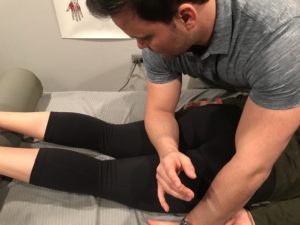
Similar to what you’d do for your quad, but flipped over. You’ll lie facedown with a roller under your ankles for support, while a therapist uses his or her forearm and elbow to apply pressure throughout your hamstring.
With a Theracane:

Sitting on a chair (preferably one that you don’t totally sink into), hold the Theracane upside-down so the end of the hook digs into your hamstring. Shift your weight so you really get the most leverage and pressure out of this position. As with your other muscles, hold the Theracane in one spot for a few deep breaths, then re-adjust to move around the different areas of tightness.
Vastus Lateralis
What Delos does:
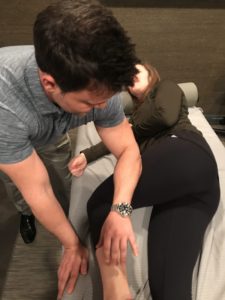
You’ll flip to one side, with your top leg bent. Your therapist will deploy his or her #delbows to apply pressure to the tight muscle. Breathe deeply — it hurts so good.
With your thumbs:
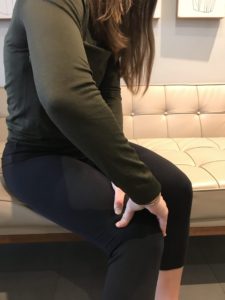
Your vastus lateralis is the front/outside of your thigh muscle, just above your knee. To treat it yourself, use your thumbs to apply pressure to the area. Careful here — you want your thumbs to be really close together, basically touching, so that the pressure you’re applying is as concentrated as possible.
Vastus Medialis
What Delos does:
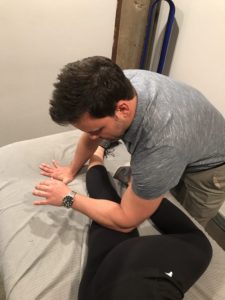
Stay right where you are — the #delbows will come to you, this time working on the vastus medialis (a.k.a. the front/inner part of your thigh just above your knee).
With your thumbs:

Dig in deep, keeping your thumbs close together. Breathe deeply and evenly, adjusting your thumbs’ positions after a few seconds of holding. You got this.
Peroneals
What Delos does:
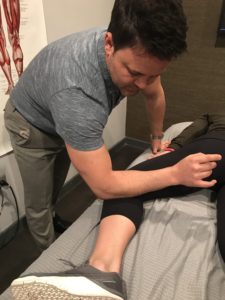
In that same side-lying position, your therapist will apply pressure to your peroneals, which are on the outside of your calves.
With your thumbs:
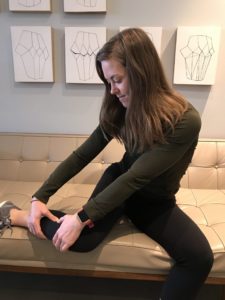
Sitting on a couch or floor, shift so that the lower part of the leg you’re working on is easily reachable. Place your hands so that your thumbs are in place to apply pressure and your fingers are all facing the same way — down. Hold pressure for a few deep breaths before moving your thumbs an inch up or down. Repeat throughout the muscle.
Of course, it’s much easier to maintain a pliable muscle than it is to restore a muscle to its original state. Owens recommends getting a jump start on maintenance before you begin a new exercise routine.
“Before you start an exercise regiment, you should start a routine to make muscles pliable. The key is to apply pressure, break up tightness, restore pliability, and THEN exercise it. Initially, a few times a week for a couple weeks is enough to break up muscle. Then, it’s easier to maintain,” depending on how much you exercise, Owens says.
Questions on how to #DelosYourself or more targeted therapy can be directed to [email protected]. If you’re suffering from knots in your neck and upper back, check out our second post in the #DelosYourself series here.












